 All Searching for the Mind posts describe intelligent behavior in nature that is difficult to explain using theories that only allow for random interactions between molecules—that is, without mind. Intelligent behavior in nature can be observed in, at least, 6 orders of magnitude from the size of a human being down to the size of cells, and an unknown number of orders of magnitude larger if we include interactions with other people and society (the entire earth would be 7 more orders of magnitude). Many different posts demonstrate recent scientific findings that implicate mind interacting with matter in the human brain, in animals, plants and cells—both microbes and human cells. Viruses, which are basically only a strand of DNA or RNA, also demonstrate complex intelligent behavior. Critical questions include where is mind in nature and what form could it take?
All Searching for the Mind posts describe intelligent behavior in nature that is difficult to explain using theories that only allow for random interactions between molecules—that is, without mind. Intelligent behavior in nature can be observed in, at least, 6 orders of magnitude from the size of a human being down to the size of cells, and an unknown number of orders of magnitude larger if we include interactions with other people and society (the entire earth would be 7 more orders of magnitude). Many different posts demonstrate recent scientific findings that implicate mind interacting with matter in the human brain, in animals, plants and cells—both microbes and human cells. Viruses, which are basically only a strand of DNA or RNA, also demonstrate complex intelligent behavior. Critical questions include where is mind in nature and what form could it take?
Most of the data for posts were discovered in the months before they were written. The vast complexity of molecular and cellular behavior is just now being uncovered. As a result, generation old dogmas, which currently dominate science, are rapidly being undermined and a new paradigm is needed. The notion that random molecular movement and “emergence” from this can explain subjective experience is a bankrupt theory. The word “emergence” is used when the mechanism is not understood.
This post will break with the website format of only referring to scientific data. It will first summarize important discoveries that infer mind interacts with matter and then offer a speculation about a possible mechanism.
Salient Recent Research
The Human Brain
Study of the human brain reveals processes that cannot be easily explained without the interaction of brain and mind.
Neuroplasticity: When a thought or learning occurs, it triggers wide-ranging changes in large brain circuits. Posts have discussed a wide range of different mechanisms that occur in hundreds of different parts of these circuits at the same time. (See post for details)
A very brief list includes:
- Changes inside neurons of scaffolding molecules and movement of mitochondria strengthening synapses.
- Complex receptor proteins that exchange their subunits.
- A cooperative alteration of both pre synaptic neurotransmitter and postsynaptic receptor.
- Triggering of specific new complex motors.
- Alterations in the post synaptic density, a complex of over a thousand interlocking unique large proteins, different each brain region.
- Complex alterations of the molecules in the extracellular space not attached to any cells.
Any one of these might be possible to explain on purely mechanistic grounds. But, having all of these alter in sync triggered by a subjective experience is impossible to explain without a unifying factor such as mind. Without some central direction, it is difficult to imagine all of this occurring at once.
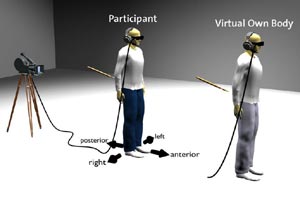 Hidden Talents: Using virtual reality gear, researchers are able to stimulate out of body experiences in ordinary people, showing a separation of mind and body. Also, psychedelics give counterintuitive results of increased mental activity with great decrease in brain activity, opening question of “doors of perception” into mind. Many triggers can stimulate very unusual spiritual experiences. Brain injuries can trigger very unusual mental capacities that appear to be repressed by brain regions.
Hidden Talents: Using virtual reality gear, researchers are able to stimulate out of body experiences in ordinary people, showing a separation of mind and body. Also, psychedelics give counterintuitive results of increased mental activity with great decrease in brain activity, opening question of “doors of perception” into mind. Many triggers can stimulate very unusual spiritual experiences. Brain injuries can trigger very unusual mental capacities that appear to be repressed by brain regions.
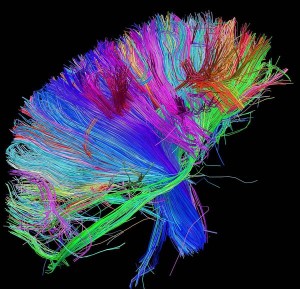 There is no Center in the Brain: Intensive study for a generation by a half a million neuroscientists worldwide has found no center in the brain for subjective experience. Recent studies show that the brain is much less modular than previously thought (modularity would go along with a computer model of the brain.) Most of the neurons are connected to multiple sensory inputs. Also, the hubs in the brain circuits are noted to have large amounts of local connections, but all also have massive long-range connections. This goes against a modular theory. Mind must interact with many different regions at once. This is also better explained by interaction with mind.
There is no Center in the Brain: Intensive study for a generation by a half a million neuroscientists worldwide has found no center in the brain for subjective experience. Recent studies show that the brain is much less modular than previously thought (modularity would go along with a computer model of the brain.) Most of the neurons are connected to multiple sensory inputs. Also, the hubs in the brain circuits are noted to have large amounts of local connections, but all also have massive long-range connections. This goes against a modular theory. Mind must interact with many different regions at once. This is also better explained by interaction with mind.
Perceptions: It is very difficult to determine what causes perceptions. Our senses are limited to narrow bands of what exists (for example the narrow band of vision, hearing, and touch among the possible frequencies). But, the perception is only somewhat determined by the sensory input. In fact, it is determined in larger amount by the expectations, memories, desires and needs. Also, somehow, perceptions from social experiences are able to influence specific gene networks in immune cells.
Animal Brains
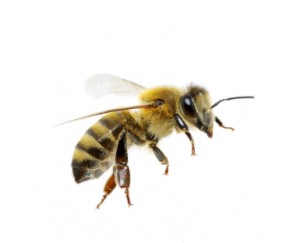 Animals are much more aware than scientists have realized, even very small animals with tiny brains.
Animals are much more aware than scientists have realized, even very small animals with tiny brains.
Animal research is demonstrating advanced cognition and social behavior in very small brains. For example, bees exhibit completely different structures related to advanced individual abilities of symbolic language, abstract concepts, advanced learning, mathematical abilities and kaleidoscopic visual memory.
Birds have demonstrated advanced verbal learning and syntax. Lizards demonstrate high intelligence and advanced social behavior. Empathy and mourning are seen through much of the animal kingdoms.
It is very difficult to explain the behavior of individual bees, ants, lizards and birds, as well as many other animals, without considering that they also share interaction with mind.
Plant Intelligence
 Plants demonstrate surprising intelligence.
Plants demonstrate surprising intelligence.
Research shows dramatic abilities of decision-making, complex communication including communication at great distance through fungal wires, and for self-defense. A plant is able to plan ahead to the time of the morning dew, to make a toxic chemical that will kill mildew at that moment. Any sooner or later they could kill themselves with the toxin.
Plants, in their fight with microbes, create new complex proteins in a constant back and forth battle. They also use RNAs in this battle.
Plants are able to determine exactly how much sugar they have until dawn and apportion the usage by mathematically dividing the amount into the time remaining. In experiments where sugar is added, they recalculate the amount and increase the hourly amount that will last till the next light. They also exhibit short term and long-term memory.
Plants are able to engineer their surroundings for their advantage.
In order to get nitrogen, plants have a very complex back and forth communication with microbes to invite them into the plant to build a nitrogen factory. This involves many steps and signals, any one of which if not answered correctly would stop the process. The plant then builds a factory around them.
Microbe Intelligence
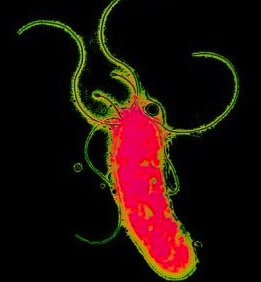 Microbes exhibit many “brainlike” capacities without a brain. They show decision-making from multiple inputs, group behavior, and advanced communication. Microbes can self-edit/mutate their genes to make special proteins to combat viruses, other microbes, and plants. These are complex large proteins that depend upon their exact shape. With the most advanced supercomputers, humans cannot calculate the folding of an average sized protein, from the codes. Yet microbes appear to know.
Microbes exhibit many “brainlike” capacities without a brain. They show decision-making from multiple inputs, group behavior, and advanced communication. Microbes can self-edit/mutate their genes to make special proteins to combat viruses, other microbes, and plants. These are complex large proteins that depend upon their exact shape. With the most advanced supercomputers, humans cannot calculate the folding of an average sized protein, from the codes. Yet microbes appear to know.
Microbes demonstrate innovations to fight autophagy in cells. One microbe, leprosy, manipulates genes turning nerve cells into stem cells and then into muscle cells;
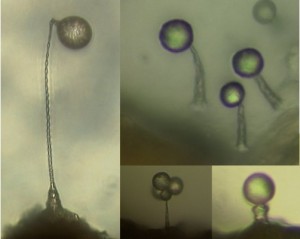 Amoeba are able to live as individual cells, then when needed to travel for food, they form what appears to be a multicellular creature made of a stalk and flowering body. The flowering body flies away in the wind or on animals’ feet, whereas the stalk sacrifices itself and stays behind. Recent studies show that family members are more likely to sacrifice for others and enter the stalk.
Amoeba are able to live as individual cells, then when needed to travel for food, they form what appears to be a multicellular creature made of a stalk and flowering body. The flowering body flies away in the wind or on animals’ feet, whereas the stalk sacrifices itself and stays behind. Recent studies show that family members are more likely to sacrifice for others and enter the stalk.
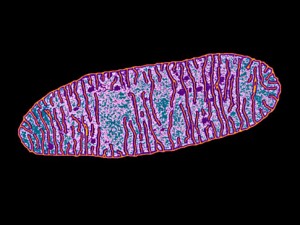 Mitochondria are previously independent microbes, who relinquished some of the freedom to live inside of our cells. In exchange for the protection of a large cell, they produce energy. They stay in constant and instantaneous contact with the functioning of the neuron. When thought occurs and dendrites and axons are being built and remodeled, the mitochondria multiply and travel to these spots to give more chemical energy for the process. Later, they will move elsewhere where necessary.
Mitochondria are previously independent microbes, who relinquished some of the freedom to live inside of our cells. In exchange for the protection of a large cell, they produce energy. They stay in constant and instantaneous contact with the functioning of the neuron. When thought occurs and dendrites and axons are being built and remodeled, the mitochondria multiply and travel to these spots to give more chemical energy for the process. Later, they will move elsewhere where necessary.
Virus Intelligence
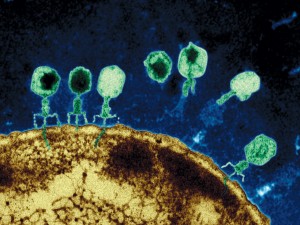 Even more remarkable are viruses, also, self-editing/mutating their DNA to form complex proteins in battle with many different foes. Viruses demonstrate complex behavior, with positive and negative relations with bacteria and humans.
Even more remarkable are viruses, also, self-editing/mutating their DNA to form complex proteins in battle with many different foes. Viruses demonstrate complex behavior, with positive and negative relations with bacteria and humans.
One example (out of thousands) traces the intelligent behavior of the herpes virus in humans. See post Virus Intelligence.
Herpes virus uses five distinct receptors to fuse with the skin cell’s membrane, allowing DNA to enter the cell. There it foils the complex nuclear pore mechanisms and enters the nucleus. With a more complex process it forms a circle of DNA and uses the cells machinery to reproduce. This new virus now leaves the skin cells and enters a neuron, where it hijacks the complex transport motors; it takes over the motor, accelerating it and directing it the long way up the axon to the nucleus where again it fools a different complex nuclear pore mechanism. In the neuron’s nucleus it changes its behavior and produces molecules that stop further activity to not kill the neuron. It can remain there for many years. Later, it is reactivated and leaves the nucleus, again travelling back on the microtubule machinery along the long axon. It, then, leaves the neuron and enters skin cells where it reproduces.
Cellular Intelligence
Neurons, immune cells, and cancer cells, which are vastly more complex than microbes, demonstrate extremely advanced communication and group activity.
Human cells use cellular self-editing in multiple different ways. They edit their own DNA for errors. They edit their own DNA in very complex ways to make antibodies and T cell receptors. They edit messenger RNA in a very complex process called alternative splicing, where what was previously considered one gene makes not one protein but up to 500.
 T cells demonstrate many intelligent functions. They mature by building complex receptors that are then able to send and receive large numbers of cytokine wireless signals. They travel through the body searching for cancer, defective cells, and microbe infested cells. But, when in the cerebrospinal fluid they control the other immune cells, and send wireless signals to brain cells, which are necessary for normal cognitive function. When there is an inflammation, in the CSF, the stimulate action from the immune cells and they signal the brain to decrease cognition with the “sick feeling”
T cells demonstrate many intelligent functions. They mature by building complex receptors that are then able to send and receive large numbers of cytokine wireless signals. They travel through the body searching for cancer, defective cells, and microbe infested cells. But, when in the cerebrospinal fluid they control the other immune cells, and send wireless signals to brain cells, which are necessary for normal cognitive function. When there is an inflammation, in the CSF, the stimulate action from the immune cells and they signal the brain to decrease cognition with the “sick feeling”
Jumping genes, transposons and retro transposons, demonstrate complex behavior, which need to be counteracted with a unique immune system inside the cell’s nucleus. Individual cells have developed different versions of the nuclear immune system, called CRISPR, to fight the massive effects of jumping genes.
Also, individual cells in different regions of the brain develop their own unique intrinsic immune systems for different bacteria and viruses with extensive innovation.
Current Unproven Theories
At this moment in the development of science, there is no way to prove any of the current theories of mind. They are all speculation.
The most popular theory of neuronal connections has many problems, some listed in my recent post, The Limits of Current Neuroscience. Electrical connection theories are complicated by chemical synapses, brain waves, astrocyte networks, cytokine communication with immune cells, extracellular space actions, as well as the unique behavior of individual neurons and the many different kinds of neurons.
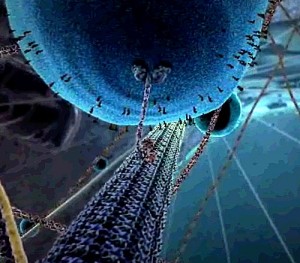 Quantum and information theories are fascinating, but many years of research remain and don’t necessarily explain subjective mind either. With non-locality, discontinuous behavior, simultaneous wave and particle nature, the physicist David Bohm said the structure of the universe is “much more reminiscent of how the organs constituting living beings are related, than it is of how parts of a machine interact.” (Wholeness and the Implicate Order, p272).
Quantum and information theories are fascinating, but many years of research remain and don’t necessarily explain subjective mind either. With non-locality, discontinuous behavior, simultaneous wave and particle nature, the physicist David Bohm said the structure of the universe is “much more reminiscent of how the organs constituting living beings are related, than it is of how parts of a machine interact.” (Wholeness and the Implicate Order, p272).
The Penrose and Hammeroff microtubules quantum theory would apply to all cells. Other quantum theories would apply to all inanimate objects as well.
Information theory is still in early stages of any feasible explanation how it could relate to subjective experience. Integrated Information Theory attempts to calculate consciousness but does not yet explain subjective experience.
All molecular theories currently have no basis to explain subjective experience.
Speculation: A Layer of Mind Beneath Physics
For thousands of years philosophers have argued many positions about the nature of mind, all with advantages and disadvantages. None are any closer to being proven scientifically. There are now a hundred different “isms” and many different synonyms for each.
The two most extreme positions are that everything is matter, materialism, and that everything is mind, idealism.
The first extreme position is basically that of modern science. There are many reasons why the view is limited. It considers mind as an epiphenomena—an emergent property of matter. Using the word “emergence” means that the mechanism is not understood.
The other extreme is that everything is mind or Spirit, some form of energy and matter coalesces from it. There are, also, many problems in explaining science with this position.
Perhaps, a more practical position is in between. The middle ground posits that energy, mind, and matter all exist in a continuum as parts of basic nature. One word for this is panpsychism. This position has some difficulties, also, but is closer to our commonsense experience in life. There are many good books on this theory. Some of the views expressed here are further described in Panpsychism In the West by David Skrbina; Unsnarling the World-Knot by David Ray Griffin; Panpsychism: The Philosophy of the Sensuous Cosmos by Ells; and Mind, Memory, Time by Carl Gunther.
There are many famous scientists, philosophers, and theologians who have expressed versions of this middle ground. An example is that of Thomas Edison, the great inventor, who wrote:
“I cannot avoid the conclusion that all matter is composed of intelligent atoms and that life and mind are merely synonyms for the aggregation of atomic intelligence.”
Commonsense View
1) The only access we have to the external world is our perception and thoughts about it. This occurs because our minds exist.
2) Perception is greatly limited by the small bandwidth of each sense—narrow bands of light, sound, touch and smell). It is also influenced by expectation and memories of previous events. There are many more neurons from the cortex interacting downward with the incoming sensory neurons, than the total number of sensory neurons providing data from the outside. Perception is affected by needs and desires. It is biased by situations. Details are missed or excluded. There are illusions, medical conditions, and errors. The multisensory brain chooses one sense over another—sight over sound.
3) Science is completely based on minds with perceptions. The only way science knows anything about the external world is by accepting that there are other minds, studying our perceptions, and seeing if a group of minds agree with the findings. Mathematical concepts are added to explain and predict these observations. All of mathematics is a subset of mind. (The notion that someone can refute the existence of mind in general by using their own mind is absurd.)
4) Bodies are observed as a perception – both our body and others’ bodies. We agree together that we are connected to each of our bodies.
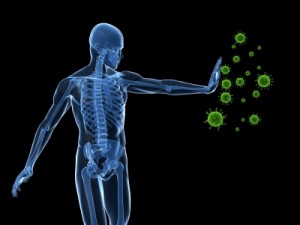 5) Some form of mind exists in animals, cells, viruses and perhaps molecules. Mind can interact instantly in at least six orders of magnitude at the same second: perception of a social interaction causes neuroplastic changes in multiple cells, alterations in multiple neuronal networks and stress circuits, and stimulation of complex genetic networks deep inside immune cells. Mind, therefore, must interact with molecular mechanisms at all of these levels at the same time.
5) Some form of mind exists in animals, cells, viruses and perhaps molecules. Mind can interact instantly in at least six orders of magnitude at the same second: perception of a social interaction causes neuroplastic changes in multiple cells, alterations in multiple neuronal networks and stress circuits, and stimulation of complex genetic networks deep inside immune cells. Mind, therefore, must interact with molecular mechanisms at all of these levels at the same time.
6) Mental functions exist in a hierarchy from virus and cells to animals and humans. Among animals there are many unique intelligences, despite the human claim to be the only superior mind.
7) Small simple mind entities that interact at molecular levels could combine into larger minds that interact with brains and society. These experiential simple mind entities must exist beneath and around all molecules and then coalesce into those large enough to interact with cells and brains.
To answer the question where is mind in nature, one possible answer is a layer of experiential subjective entities of proto-mind beneath physics.